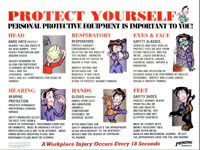 |
 |
| MSDS Topics |
Free Sites | FAQ's | Regulations | Glossary | Software | Suppliers |
| Books | Forum | Poll | Fun stuff | Quiz | Store | |
| MSDS and safety supplies | Search ALL our MSDS info | |||||
 | |||
 |
 |
 |
|
| Title: 09/06/1991 - Requirement of Carcinogen warning label on textile glass filaments. | |
| Record Type: Interpretation | Standard Number: 1910.1200 |
September 6, 1991
Mr. Anthony J. Thompson
Perkins Coie
607 Fourteenth Street, N.W.
Washington, D.C. 20005-2011
Dear Mr. Thompson:
Thank you for your letter of August 22, to the Occupational Safety and Health Administration (OSHA), in which you requested a clarification of the application of the requirements of the Hazard Communication Standard (HCS), 29 CFR 1910.1200, to continuous glass filaments. You specifically were concerned about the requirement that continuous filament (also known as, according to your letter, "textile glass fibers") products bear a carcinogen warning label.
The HCS requires employers to perform a hazard determination for the product(s) they manufacture to determine if, under normal conditions of use or in an emergency, workplace handling or use of their product can or could result in employee exposure to a hazardous chemical(s). OSHA does not perform these hazard determinations for manufacturer; rather, it is up to the manufacturer to consider all available scientific evidence concerning the hazardous effects of that chemical. No testing is required and the evaluation may be based solely on information currently available in the scientific literature (see 29 CFR 1910.1200, paragraph (d)).
In your letter you mention that the International Agency for Research on Cancer (IARC) "concluded that continuous filaments are not classifiable as carcinogenic to humans" and therefore, you requested that OSHA "confirm" that no carcinogen warning label is needed for these products. IARC is recognized in the text of the HCS itself as one source manufacturers of hazardous chemicals must consider regarding a chemical's carcinogenicity, but it is not the only source. For health hazards including carcinogenicity, evidence which is statistically significant and which is based on at least one positive study conducted in accordance with established scientific principles is considered to be sufficient to establish a hazardous effect.
|
If statistically significant evidence exists that exposure to the textile glass or continuous glass filament products your client manufactures, or the fibers emitted during workplace handling of these products, is or has been associated with a health effect from those exposures, then that information must appear on the MSDS, and appropriate hazard warnings conveying that information must appear on container labels for the product. As discussed above, the hazard determination, in this regard, is your client's responsibility as the manufacturer to perform and substantiate. The manufacturer must identify the studies that involve the type of fiber they produce. Hazard determinations are not based on analogy (as to the recent OSHA news release on "fibrous glass"), but rather must assess existing data on the specific material involved. If the material is not available for exposure due to its physical form, this should also be factored into the hazard determination. For example, if fibers are not ever of respirable size, inhalation hazards would not be of concern.
|  Safety posters are a terrific way of reminding employees of proper procedure. Get yours at Safety Emporium. |
For your further clarification on this subject, we are enclosing a copy of OSHA's compliance Instruction on the HCS, CPL 2-2.38C. A copy of the Agency's July 28 new release on fibrous glass is also included for your reference.
A copy of this letter to you will be transmitted to all of OSHA's Regional Offices in response to your concerns regarding labeling of the products you mentioned. Please feel free to contact us again if we can be of further assistance.
Sincerely,
Patricia K. Clark, Director
Directorate of Compliance Programs
Enclosures
August 22, 1991
By Hand
Ms. Patricia K. Clark, Director
Directorate of Compliance Programs
Occupational Safety and Health Administration
U.S. Department of Labor
200 Constitution Avenue, N.W., Rm N-3469
Washington, DC 20210
Re: Continuous Glass Filaments
Dear Ms. Clark:
Several of our clients' customers have asked us to clarify with OSHA that continuous glass filaments (also known as textile glass fibers) do not require a warning label under the Hazardous Communications Standard (HCS). We are also aware of at least one circumstance where a compliance officer appears ready to cite a customer for not having a cancer warning on a continuous filament product.
As you know, 0wens-Corning Fiberglas Corporation (OCF) currently labels its glass wool products for possible carcinogenic and irritant effects. The International Agency for Research on Cancer (IARC), the Environmental Protection Agency (EPA) and other leading scientific bodies distinguish continuous filament products from glass wool products. IARC concluded that continuous filaments are not classifiable as carcinogenic to humans (see enclosure). We ask that you confirm and notify your regional offices that the HCS does not require continuous filament products to be labeled.
Very truly yours,
Anthony J. Thompson
The official, public domain, OSHA version of this document is available at http://www.osha.gov/pls/oshaweb/owadisp.show_document?p_table=INTERPRETATIONS&p_id=20387&p_text_version=FALSE